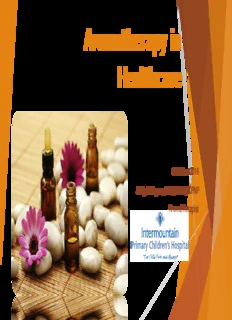
Aromatherapy in Healthcare PDF
Preview Aromatherapy in Healthcare
Aromatherapy in Healthcare October 2016 Jody Osteyee, DNP, APRN, CPNP Aromatherapist disclosure statement The presenter has no relationships with any commercial entity. Products shown are for education purposes only and not for personal or professional gain of the presenter. tell me about you… objectives Identify sources of reputable information about essential oil (EO) use. Describe the science of essential oils. Discuss the evidence-base for using EOs in healthcare. Identify key components of EO use at healthcare facilities. references and resources Books Tisserand R & Young R: Essential Oil Safety. A Guide for Health Care Professionals 2nd Ed., 2014, Churchill Livingston, New York, New York Buckle, J: Clinical Aromatherapy: Essential oils in Practice, Third Edition; 2015; Elsevier, St. Louis, Mo. Price S & Price L. (Eds.) (2012) Aromatherapy for Health Professionals 4th ed. Edinburgh: Churchill Livingstone Schnaubelt, K: Advanced Aromatherapy: The Science of Essential Oil Therapy, 1998, Healing Arts Press, Rochester, Vermont Schnaubelt, K: Medical Aromatherapy, Healing with Essential Oils, 1999, Frog, Ltd., Berkeley, California Battaglia, S. (2003). The Complete Guide to Aromatherapy 2nd ed. Brisbane:The International Centre of Holistic Aromatherapy Singh S & E Ernst. (2008) Trick or Treatment? Alternative medicine on Trial. WW Norton & Co. People Robert Tisserand, Robert Young, Jane Buckle, Jade Shutes, Kurt Schnaubelt references and resources Associations Alliance of International Aromatherapists http://www.alliance-aromatherapists.org/. National Association for Holistic Aromatherapy (NAHA) http://www.naha.org/about/mission/ NIH National Center for Complementary and Integrative Health http://nccih.nih.gov/health/aromatherapy Education resources Integrative therapies education http://www.csh.umn.edu/free-online-learning-modules/index.htm NAHA approved aromatherapy schools; NAHA website American College of Healthcare Sciences, Oregon http://achs.edu/resource/webinars/index.html Aromahead Institue, School of Essential Oil Studies, Florida www.aromahead.com Journals NAHA Aromatherapy Journal International Journal of Clinical Aromatherapy http://www.ijca.net/ (Peer reviewed) International Journal of Professional Holistic Aromatherapy http://www.ijpha.com/ (Peer reviewed) references and resources Articles Vitale, A (2014) Initiating a Reiki or CAM program in a Healthcare Organization-Developing a Business Plan. Holist Nurs Pract. 28(6):376-380. This is the November-December issue. Useful info for program development. Soo Lee M, Choi J, Posadzki P & Ernst E. (2012) Aromatherapy for health care: An overview of systematic Reviews. Maturitas 71; 257-260. Campbell L, Pollard A & C Roeton. (2001) The development of clinical practice guidelines for the use of aromatherapy in a cancer setting. The Australian Journal of Holistic Nursing 8(1):144-22. Stea S, Beraudi A & D DePasquale. (2014) Essential Oils for Complementary Treatment of Surgical Patients: State of the Art. Evidence-Based Complementary and Alternative Medicine. Article ID 726341, pages 1-6. Joswiak D, Kinney ME, Johnson JR, Kolste AK, Griffin KH, Rivard RL & JA Dusek. (2016) Development of a Health System-based Nurse-Delivered Aromatherapy Program. Journal of Nursing Administration 46(4):221- 225. Lytle J, Mwatha C & KK Davis. (2014) Effect of Lavender Aromatherapy on Vital Signs and Perceived Quality of Sleep in the Intermediate Care Unit; A Pilot Study. AJCC 23(1):24-30. Lua PL & NS Zakaria. (2012) A Brief Overview of Current Scientific Evidence Involving Aromatherapy Use for Nausea and Vomiting. The Journal of Alternative and Complementary Medicine 18(6):534-540. evidence behind EOs Blinded randomized control trials are challenging Placebo effect Evidence-based practice vs. practice-based evidence Avoid pseudo-science See books by Jane Buckle, and Shirley and Len Price terminology Aromatherapy: the use of essential oils derived from plants; aesthetic, clinical, holistic (Buckle); inhalation and topical application of true, authentic EOs from aromatic plants to restore or enhance health, beauty and well-being (AIA) also referred to as Essential Oil therapy, can be defined as the art and science of utilizing naturally extracted aromatic essences from plants to balance, harmonize and promote the health of body, mind and spirit. It seeks to unify physiological, psychological and spiritual processes to enhance an individual’s innate healing process.” (NAHA) Aromatherapist: one who has completed recognized training in aromatherapy at the minimum level of 200 educational contact hours approved by AIA, or who has passed a standardized exam ( Aromatherapy Registration Council) Essential oil (EO): substance distilled from aromatic plants( leaf, bark, peel, resin, etc.). Each oil has a variety of chemical constituents which determine the effect of the oil. Holistic Nursing… EO science Kingdom Example: Division Lavendula angustifolia - Lavender Boswellia carterii - Frankincense Subdivision Rosa damescena – Rose Class Melaleuca alternifolia – Tea tree Subclass Eucalyptus radiata – Eucalyptus Order Eucalyptus dives Eucalyptus globulus Family Eucalyptus polybractea Genus Your EO bottles should be labeled with botanical names Species Also… variety, chemotype, hybrid
Description: